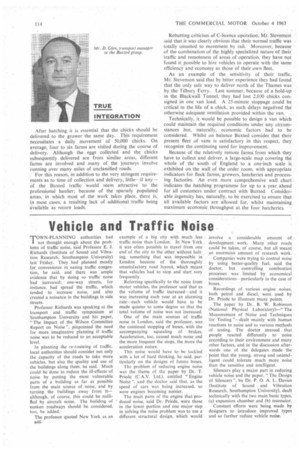Vehicle and Traffic Noise
Page 116

If you've noticed an error in this article please click here to report it so we can fix it.
TOWN-PLANNING authorities had J. not thought enough about the problems of traffic noise, said Professor E. J. Richards (Institute of Sound and Vibration Research, Southampton University) lastFriday. They had planned mostly for convenience in easing traffic congestion, he said, and there was ample evidence that by doing so traffic noise had increased; one-way streets, for instance, had spread the traffic, which tended to increase noise, and also created a nuisance in the buildings in side streets.
Professor Richards was speaking at the transport and traffic symposium at Southampton University and his paper, "The Impact of the Wilson Committee Report on Noise ", pinpointed the need for more imaginative planning if traffic noise was to be reduced to an acceptable level.
In planning the re-routeing of traffic, local authorities should consider not only the capacity of the roads to take more vehicles, but also the quality and use of the buildings along them, he said. Much could be done to reduce the ill-effects of noise by putting the most vulnerable parts of a building as far as possible from the main source of noise, and by turning the buildings away from it— although, of course, this could be nullified by aircraft noise. The building of sunken roadways should be considered, too, he added.
The professor quoted New York as an azI6 example of a big city .with much _less traffic noise than London. In New York it was often possible to travel from one end of the city to the Other without halting, something that was impossible in London because of the thoroughly unsatisfactory road layout, -which meant that vehicles had to stop and start very frequently.
Referring specifically to the noise from motor vehicles, the professor said that as the volume of traffic increased—and it was increasing each year at an alarming rate—each vehicle would have to be made quieter to some degree so that the total volume of noise was not increased.
One of the main sources of traffic noise in London, said the professor, was the continual stopping of buses, with the accompanying squealing of brakes. Acceleration, too, caused much noise and the more frequent the stops, the more the acceleration noises.
This noise would have to be tackled with a lot of hard thinking, he said, particularly on the designs of future buses.
The problem of reducing engine noise was the theme of the paper by Dr. T. Priede (C.AN. Ltd.). entitled "Engine Noise ", and the doctor said that, as the speed of cars was being increased, so were engines becoming noisier.
The main parts of the engine that produced noise, said Dr. Priede, were those in the lower portion and one major step in solving the noise problem was to use a different structural design, which would involve a considerable amount of development. work. Many other roads could be taken, of course. but all meant an enormous. amount of research work:
Companies were trying to control noise by using better-quality fuel, said the doctor, but controlling combustion processes was limited by• economical considerations—particularly in the case of buses.
Recordings of various engine noises, both petrol and diesel, were used by Dr. Priede to illustrate many points.
The paper by Dr. B. W. Robinson (National Physical Laboratory)—" The Measurement of Noise and Techniques for Testing "—dealt mainly with human reactions to noise and to various methods of testing. The doctor stressed that people reacted differently to noise according to their environment and many other factors, and in the discussion afterwards one of the delegates made the point that the young. strong and unintelligent could tolerate much more noise than the sensitive and intelligent.
Silencers play a major part in reducing vehicle noise and the paper, "The Design of Silencers". by Dr. P. 0. A. L. Davies (Institute cif Sound and Vibration Research. Southampton University), dealt technically with the two main basic types, (a) expansion chamber and (b) resonator.
• Constant efforts were being made by designers to introduce improved types and so further reduce vehicle noise.








































































































































































